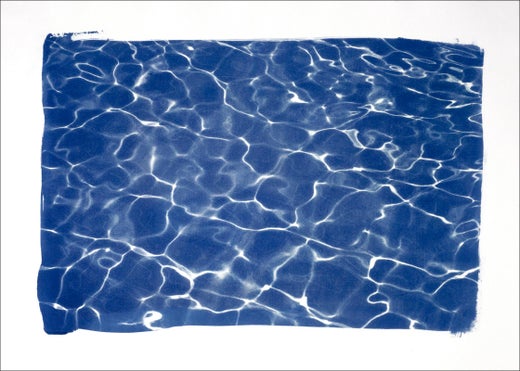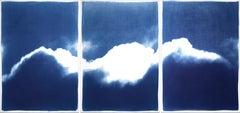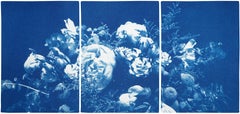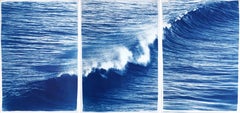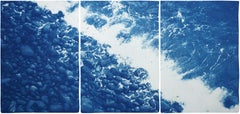Video Loading
Want more images or videos?
Request additional images or videos from the seller
1 of 17
Kind of CyanLos Angeles Crashing Waves, Handmade Cyanotype on Paper, Nautical Seascape, Blue2022
2022
Price:$728.95
$920List Price
About the Item
- Creator:Kind of Cyan (1984, American)
- Creation Year:2022
- Dimensions:Height: 40 in (101.6 cm)Width: 83 in (210.82 cm)
- More Editions & Sizes:Edition of 100Price: $760
- Medium:
- Movement & Style:
- Period:
- Condition:
- Gallery Location:Barcelona, ES
- Reference Number:Seller: T0121stDibs: LU1310212164222
Kind of Cyan
Kind of Cyan is an art collective based in Barcelona, Spain, that specializes in producing cyanotype prints, also known as sun prints. This 19th-century printing technique uses UV-light to create images with a rich, intense blue hue that is both nostalgic and contemporary. The collective's archive includes a range of medium to large sized works that are perfect for filling large walls and open spaces. Each piece is either part of a small edition or a completely unique monotype, ensuring that every artwork is one-of-a-kind. Through their use of the cyanotype process, Kind of Cyan creates visually stunning works that are both nostalgic and contemporary. Their prints capture the essence of the natural world and evoke a sense of wonder and awe, with a deep appreciation for the history of photography and an understanding of design fundamentals that will beautifully enhance any space.
About the Seller
4.9
Platinum Seller
Premium sellers with a 4.7+ rating and 24-hour response times
Established in 2016
1stDibs seller since 2019
717 sales on 1stDibs
Authenticity Guarantee
In the unlikely event there’s an issue with an item’s authenticity, contact us within 1 year for a full refund. DetailsMoney-Back Guarantee
If your item is not as described, is damaged in transit, or does not arrive, contact us within 7 days for a full refund. Details24-Hour Cancellation
You have a 24-hour grace period in which to reconsider your purchase, with no questions asked.Vetted Professional Sellers
Our world-class sellers must adhere to strict standards for service and quality, maintaining the integrity of our listings.Price-Match Guarantee
If you find that a seller listed the same item for a lower price elsewhere, we’ll match it.Trusted Global Delivery
Our best-in-class carrier network provides specialized shipping options worldwide, including custom delivery.You May Also Like
Wall Street 2, black & white 25.5" X 36" lithograph abstract urban street NYC
Located in Brooklyn, NY
Wall Street 2 - plate size 25.5 x 36 - printed on 100% cotton rag - edition 3/5
monochromatic city-scape w/ Architectural elements
Cubist and abstract assemblage photographic character
Category
2010s American Realist Landscape Prints
Materials
Archival Ink, Archival Paper, Rag Paper, Lithograph
Wall Street 1, 25.5 x 36 inches, black/white lithograph, abstract urban city NY
Located in Brooklyn, NY
Wall Street 2 - plate size 25.5 x 36 - printed on 100% cotton rag - edition 3/5
monochromatic city-scape w/ Architectural elements
Cubist and abstract assemblage photographic character
Category
Early 2000s American Realist Landscape Prints
Materials
Archival Ink, Archival Paper, Rag Paper, Lithograph
Untitled, architectural monochromatic urban skyscraper w male figures
Located in Brooklyn, NY
Spring St. SI,
Artists proof
printed on 100% cotton rag
monochromatic
Panoramic
Category
Early 2000s American Realist Landscape Prints
Materials
Archival Ink, Archival Paper, Rag Paper, Lithograph
$2,000
H 39 in W 27.75 in D 0.1 in
Untitled, Face
Located in Brooklyn, NY
untitled vintage etching of face
reminiscent of mid-century modern esthetic
image 23.5" x 18"
Artists proof
printed on 100% cotton rag
monochromatic
Panoramic
Category
1980s American Realist Landscape Prints
Materials
Archival Ink, Archival Paper, Rag Paper, Etching
The Weeping Condo, dark, monochromatic urban building w grid in design
Located in Brooklyn, NY
Weeping Condo
38.5 x 22
image size: 36" x 19.5"
Artists proof
printed on 100% cotton rag
monochromatic
Panoramic
Dark. mysterious vintage work by Esteban Chavez
Category
1980s American Realist Landscape Prints
Materials
Archival Ink, Archival Paper, Rag Paper, Etching
$3,000
H 38.5 in W 22.5 in
"Fishing Village" Joe Jones, Mid-Century, American Life, Small Town Scene
By Joe Jones
Located in New York, NY
Joe Jones
Fishing Village, 1949
Signed in pencil lower right margin
Lithograph on wove paper
Image 9 5/16 x 12 9/16 inches
Sheet 12 x 15 15/16 inches
From the edition of 250
The initial details of Jones' career are sparse, and this is intentional. The young artist was engaged in a process of self-reinvention, crafting a persona. When he submitted a work to the Sixteen Cities Exhibition at New York City's Museum of Modern Art in 1933, he briefly characterized himself: "Born St. Louis, 1909, self-taught. " Jones intentionally portrayed himself to the art community as an authentic working-class figure, backed by a compelling history. He was the youngest of five children in a family led by a one-armed house painter from St. Louis, a Welsh immigrant, and his German American spouse. At the age of ten, Jones found himself in a Missouri reformatory due to authorities' concerns over his graffiti activities. After completing elementary school, he traveled by freight car to California and back, even being arrested for vagrancy in Pueblo, Colorado. Returning to St. Louis, he attempted to settle down by working alongside his father. Yet, Jones felt a profound restlessness and was drawn toward a more elevated artistic pursuit in his late teenage years. He discovered a local collective of budding artists that formed St. Louis’s "Little Bohemia," sharing a studio and providing mutual support until he managed to secure his own modest workspace in a vacant garage.
Jones’s initial creations comprised still lifes, landscapes, and poignant portraits of those close to him. These subjects were not only accessible but also budget-friendly, as hiring models was beyond his means. He depicted himself, his father, mother, and eventually, his wife. In December 1930, at the age of 21, Jones wed Freda Sies, a modern dancer and political activist who was four years older than him.
By 1933, Jones had started gaining noteworthy local recognition through a solo exhibition at the Artists’ Guild of Saint Louis. Of the twenty-five paintings on display, one, titled River Front (private collection, previously with Hirschl and Adler Galleries), was selected to illustrate a feature article about his show in The Art Digest (February 15, 1933, p. 9). Shortly before this exhibition, a young surgeon named Dr. Robert Elman took an interest in Jones’s art, purchasing several pieces and forming a group of potential patrons committed to providing the emerging artist with a monthly stipend in exchange for art. This group was officially known as the "Co-operative Art Society," but it was informally dubbed the "Joe Jones Club. " Jones became an active participant in the St. Louis artistic scene, particularly within its bohemian segments. He embraced modernism and was a founding member of the "New Hat" movement in 1931, a playful rebellion against the conservative and traditional mainstream art establishment.
The summer of 1933 marked a significant shift in Jones’s journey. Sponsored by a dedicated ally, Mrs. Elizabeth Green, Jones, along with Freda and Green, embarked on an eastward road trip. In Washington, D. C., they explored the Corcoran Gallery of Art, the Freer Gallery (part of the Smithsonian Institution), the Library of Congress, and Mount Vernon. Following this whirlwind of art and American culture, they made their way to New York, where they visited various museums and galleries, including a stop at The New School for Social Research, which featured notable contemporary murals by fellow Missourian Thomas Hart Benton and the politically active Mexican artist, José Clemente Orozco. From June through August, Jones and Freda resided in the artist colony of Provincetown, Massachusetts, later returning home via Detroit to see Diego Rivera’s Detroit Industry mural housed at the Detroit Institute of Fine Arts.
While Elizabeth Green allegedly hoped that Jones would refine his artistic skills under the guidance of Charles Hawthorne or Richard Miller in Provincetown, Jones followed a different path. Rather than pursuing conservative mentors, he connected with an engaging network of leftist intellectuals, writers, and artists who dedicated their time to reading Marx and applying his theories to the American landscape. Jones's reaction to the traditional culture of New England was captured in his statement to a reporter from the St. Louis Post Dispatch: “Class consciousness . . . that’s what I got of my trip to New England. Those people [New Englanders] are like the Chinese—ancestor worshipers. They made me realize where I belong” (September 21, 1933). The stark social divisions he witnessed there prompted him to embrace his working-class identity even more fervently. Upon returning to St. Louis, he prominently identified himself as a Communist. This newfound political stance created friction with some of his local supporters. Many of his middle-class advocates withdrew their backing, likely influenced not only by Jones’s politics but also by his flamboyant and confrontational demeanor.
In December 1933, Jones initiated a complimentary art class for unemployed individuals in the Old Courthouse of St. Louis, the same location where the Dred Scott case was deliberated and where slave auctions formerly took place. Concurrently, the St. Louis Art League was offering paid courses. Emphasizing the theme of social activism, with a studio adorned with Soviet artwork, Jones’s institution operated for just over a year before being removed from the courthouse by local officials. The school’s political focus and unconventional teaching practices, along with its inclusion of a significant number of African American students during a period marked by rigid racial segregation, certainly contributed to its challenges. Under Jones’s guidance, the class created a large chalk pastel mural on board, measuring 16 by 37 feet, titled Social Unrest in St. Louis. Mural painting posed no challenge for the former housepainter, who was adept at handling large wall surfaces. His first significant commission in St. Louis in late 1931 was a mural that celebrated the city’s industrial and commercial fortitude for the local radio station, KMOX. This mural, aimed at conveying optimism amid severe economic hardship, showcased St. Louis's strengths in a modernist approach. When Jones resumed mural work in late 1933, his worldview had evolved considerably. The mural produced for the school in the courthouse, conceived by Jones, featured scenes of modern St. Louis selected to highlight political messages. Jones had observed the technique of utilizing self-contained scenes to craft visual narratives in the murals he encountered in the East. More locally, this compositional strategy was commonly employed by the renowned Missouri artist...
Category
1940s American Realist Landscape Prints
Materials
Paper, Lithograph
$900
H 16.25 in W 20.25 in
"Windy Hill" Lawrence Beall Smith, Mid-Century Realist Scene, American Life
By Lawrence Beall Smith
Located in New York, NY
Lawrence Beall Smith
Windy Hill, 1948
Signed in pencil lower right margin
Lithograph on wove paper
Image 10 3/8 x 13 1/16 inches
Sheet 11 15/16 x 16 inches
From the edition of 250
...
Category
1940s American Realist Figurative Prints
Materials
Lithograph, Paper
"The Slope Near the Bridge" Paul Sample, Mid-Century, American Snowy Landscape
By Paul Sample
Located in New York, NY
Paul Sample
The Slope Near the Bridge, 1950
Signed in pencil lower left
Lithograph on wove paper
Image 8 15/16 x 12 15/16 inches
Sheet 11 5/16 x 15 1/16 inches
From the edition of 25...
Category
1950s American Realist Figurative Prints
Materials
Paper, Lithograph
$900
H 16.25 in W 20.25 in
"City Park, Winter" Aaron Bohrod, Mid-Century, American Realist Nocturne
By Aaron Bohrod
Located in New York, NY
Aaron Bohrod
City Park, Winter, circa 1945
Signed in pencil lower right margin
Lithograph on wove paper
Image 9 1/2 x 13 1/2 inches
From the edition of 250
Aaron Bohrod's work has ...
Category
1940s American Realist Figurative Prints
Materials
Lithograph, Paper
$900
H 16.25 in W 20.25 in
MISSOURI MOUSE - Large Folio "The Viviparous Quadrupeds of North America" Pl.100
By After John James Audubon
Located in Santa Monica, CA
(After) JOHN JAMES AUDUBON (1785 - 1851)
MISSOURI MOUSE, 1846 - Plate 100 (C) No. 20
Lithograph with original hand coloring. From Audubon's "The Viviparous Quadrupeds of North America...
Category
1840s American Realist Landscape Prints
Materials
Lithograph
$600 Sale Price
20% Off
H 16 in W 22 in
More From This Seller
View AllWaves of Clouds, Deep Blue Cyanotype Print, Pleasant Cloudy Sky, Large Triptych
By Kind of Cyan
Located in Barcelona, ES
This series of cyanotype triptychs showcases the beauty of nature scenes, including stunning beaches and oceans, as well as the intricate textures of water, forests, and skies. These triptychs are large pieces that feature lush blues, making them an impressive addition to any beautifully designed space.
Each triptych is printed by hand and carefully crafted to capture the unique essence of these natural environments, with a focus on the interplay of light and shadows, and the subtle nuances of tone and texture.
The beach and ocean scenes depict the dynamic beauty of waves crashing against the shore, with the cyanotype process lending a dreamy, ethereal quality to the images. Similarly, the forest and wood scenes...
Category
2010s American Realist Landscape Paintings
Materials
Lithograph, Rag Paper
Floral Triptych of Large Floral Bouquet, Botanical Cyanotype in Classic Blue
By Kind of Cyan
Located in Barcelona, ES
This series of cyanotype triptychs showcases the beauty of nature scenes, including stunning beaches and oceans, as well as the intricate textures of water, forests, and skies. These...
Category
2010s American Realist Landscape Paintings
Materials
Watercolor, Lithograph, Rag Paper
Los Angeles Crashing Waves, Handmade Cyanotype on Paper, Nautical Seascape, Blue
By Kind of Cyan
Located in Barcelona, ES
This series of cyanotype triptychs showcases the beauty of nature scenes, including stunning beaches and oceans, as well as the intricate textures of water, forests, and skies. These...
Category
2010s American Realist Landscape Prints
Materials
Rag Paper, Lithograph
Nautical Triptych Blue Pebble Beach Handmade Cyanotype, Watercolor Paper
By Kind of Cyan
Located in Barcelona, ES
This series of cyanotype triptychs showcases the beauty of nature scenes, including stunning beaches and oceans, as well as the intricate textures of water, forests, and skies. These...
Category
2010s American Realist Landscape Prints
Materials
Paper, Lithograph, Monotype
Blue Tones Triptych, Serene Gorgeous Clouds, Handmade Cyanotype Watercolor Paper
By Kind of Cyan
Located in Barcelona, ES
This series of cyanotype triptychs showcases the beauty of nature scenes, including stunning beaches and oceans, as well as the intricate textures of w...
Category
2010s American Realist Landscape Paintings
Materials
Emulsion, Lithograph, Monotype, Handmade Paper
Mediterranean Seascape, Nautical Cyanotype on Watercolor Paper, Blueprint
By Kind of Cyan
Located in Barcelona, ES
This is an exclusive handprinted limited edition cyanotype.
"Mediterranean Blue Sea Waves" is a handmade cyanotype print of the subtle tidal flow moving in on the Mediterranean Sea.
...
Category
2010s Realist Landscape Photography
Materials
Emulsion, Watercolor, Rag Paper, Lithograph
Recently Viewed
View AllMore Ways To Browse
Thomas Mcknight Serigraph
Watanabe Woodcut
Wayne Thiebaud Landscapes
Altman Central Park
Aspen Poster
Aspen Retro Poster
Ben Harman
Callahan Kevin
Christo and Jeanne-Claude On Sale
Christo Pont Neuf
David Hockney Arrival Of Spring
Earle Eyvind
Etchings New England
Giovanni Battista Falda
Harold Altman Central Park
Hawaiian Airlines Vintage Posters
Hendrik Adriaan Van Rheede Tot Drakenstein
Hiroshige Bridge
